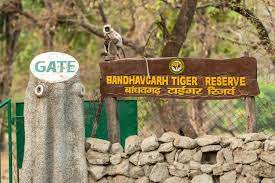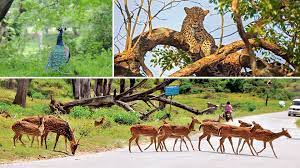Top Jungle Safaris in India: A Guide

Table of Contents
Embark on an exhilarating journey through India’s wild heartlands, where adventure awaits at every turn. Your love for the untamed will find its match in the country’s top jungle safari destinations. With landscapes ranging from dense forests to sprawling grasslands, India’s biodiversity hotspots offer more than just a glimpse into the lives of some of the rarest creatures on the planet.
Imagine the thrill of spotting a majestic tiger in its natural habitat or the serenity of watching a herd of deer graze in the distance. India’s jungle safaris promise these unique experiences and much more. Whether you’re a wildlife enthusiast or simply seeking an escape into nature, prepare for a safari adventure that’ll leave you with stories to tell for a lifetime.
Kaziranga National Park

Embark on a safari in Kaziranga National Park and immerse yourself in the habitat of the endangered one-horned rhinoceros. Recognised as a UNESCO World Heritage Site, Kaziranga’s complex ecosystem comprises marshy grasslands, wetlands, and dense forests. This incredible diversity supports not just the prehistoric-looking rhinos, but also a significant population of tigers, elephants, and a myriad of bird species that add colour and song to the untamed scenery.
As you plot your safari adventure, timing is crucial. The park gates are open to visitors from November to April, presenting the ideal window for wildlife experiences. Specifically, the winter months of December and January are exceptional for sightings, with the cool air and clear skies making for comfortable excursions.
When to Go for the Best Experience
Here’s a quick guide on when to visit Kaziranga to maximise your chances of memorable wildlife encounters:
| Best time to visit | Season | Park accessibility | Wildlife sightings |
|---|---|---|---|
| November to April | Non-monsoon | Open | High |
| December to January | Winter | Open | Excellent |
| May to October | Monsoon | Closed | Inaccessible |
Keep in mind, during the monsoon season from May to October, heavy rainfall leads to park closures, thus it’s advisable to avoid planning your trip in this period.
- Early Morning Drives: Opt for these to witness the jungle’s residents as they start their day.
- Silent Observation: Keep noise to a minimum; it heightens your chances of spotting the shy and elusive creatures.
- Respect the Habitat: Remember, you’re in the home of these animals; maintain a safe distance and do not disturb their natural behaviour.
Embarking on a safari in Kaziranga National Park offers an experience that’s both exhilarating and humbling. You’ll find yourself in awe of the sheer diversity and abundance of wildlife, creating memories that resonate with the raw beauty and rhythm of nature.
Remember, there’s no Wi-Fi in the forest, but you’ll find a better connection.
Jim Corbett National Park

Nestled in the foothills of the Himalayas in Uttarakhand, Jim Corbett National Park is one of India’s oldest and most revered wildlife sanctuaries. Established in 1936 to protect the Bengal tiger, this park named after the legendary hunter-turned-conservationist sets the gold standard for tiger reserves across the world.
Wildlife and Ecosystem
Jim Corbett’s landscapes are as diverse as they are dramatic: from deciduous forests and grasslands to marshy depressions and riverine belts, it’s home to a vast array of flora and fauna. Here, you’ll spot not just the majestic tigers in their natural habitat but also leopards, Indian elephants, sambar deer, and more than 650 species of birds. Your visit promises sightings of wildlife thriving in an environment that’s been painstakingly preserved.
Safari Experiences
When embarking on a safari in Jim Corbett, you’re signing up for a journey that’s exciting at every turn. Safaris usually occur twice a day – an early morning ride, ideal for catching nocturnal animals before they retreat, and an afternoon drive, perfect for observing the diverse birdlife and basking in the warm golden light.
- Jeep Safari: For a close encounter with nature
- Elephant Safari: For unmatched viewpoints
- Canter Safari: Suitable for larger groups
Safaris are conducted by seasoned guides who know the park’s every nook and cranny, ensuring that you’re always at the forefront of wilderness adventures.
Best Time to Visit
Visit between November and June for the best wildlife viewing, as the park is closed during the monsoon season. Peak sighting months are December through March, with animals frequently appearing near water bodies.Booking your safari in advance is highly recommended, as permits are limited.
Embrace the rugged beauty of Jim Corbett National Park and its residents in an experience that’s nothing short of magnificent. With careful planning and a sense of adventure, you’re likely to leave with stories for a lifetime.
Gir National Park

Nestled in the rugged terrains of Gujarat, Gir National Park offers an encounter with the Asiatic lion, a species once on the brink of extinction. It’s the only place in the wild where you can witness these magnificent creatures roam freely.
As you traverse the deciduous forests spread across 1,412 square kilometers, you’re also likely to spot an array of other wildlife. The park is home to leopards, hyenas, antelopes, and over 300 species of birds. The unique ecosystem of Gir provides a rare opportunity to observe a rich biodiversity.
Safari Adventures in Gir
To immerse yourself in the wilderness of Gir:
- Embark on thrilling jeep safaris that navigate through the dusty trails.
- Opt for guided tours that offer insightful commentary on the park’s flora and fauna.
- Safaris are available from mid-October to mid-June, but the best time to visit is December to March, when the weather is cooler and the chances of sighting lions are high.
Booking your safari in advance is crucial as the park regulates the number of vehicles entering the area to minimize the impact on wildlife.
Essential Safari Tips
While planning your safari, it’s important to take note of a few key tips:
- Dress in neutral colors to blend in with the natural surroundings.
- Carry a good pair of binoculars for bird watching and spotting animals from afar.
- Stay calm and silent during sightings; sudden noises can disturb the wildlife.
- Ensure you adhere to the park rules and maintain a safe distance from all animals.
By respecting these guidelines, your Gir National Park safari is sure to be an unforgettable experience. You’ll carry home memories of the king of the jungle that will last a lifetime.
Ranthambore National Park


As you delve deeper into India’s wildlife sanctuaries, Ranthambore National Park in Rajasthan stands out as a beacon for tiger enthusiasts and wildlife photographers. One of the largest national parks in northern India, Ranthambore is a former royal hunting ground that has been transformed into a dynamic sanctuary for the Bengal tiger.
This park’s rugged terrain, dotted with ancient ruins, including the majestic Ranthambore Fort, sets the scene for a truly spirited wildlife adventure. The dry deciduous forests are home to a myriad of species, including leopards, striped hyenas, sambar deer, and sloth bears.
Jeep safaris offer the best avenue for navigating the park’s expansive terrain. You’ll be enchanted by the sights of tigers ambling through the forest or lounging in the sun. The safaris, conducted twice a day, maximize your chances of an encounter with the elusive predators.
Here’s what you need to know to ensure a seamless safari experience in Ranthambore:
- Best Time to Visit: October to June, with peak sightings from March to May.
- Safari Bookings: Advance booking is recommended; it’s done online and often fills up weeks in advance.
- Photography Tips: Bring a telephoto lens for capturing wildlife from a distance. Avoid flash photography to prevent disturbing the animals.
While the Bengal tiger is certainly the park’s pièce de résistance, don’t overlook its other residents. The park is a haven for bird watchers, with over 270 avian species including the crested serpent eagle and the Indian grey hornbill.
At Ranthambore, the interplay between history and nature is palpable. Explore the park’s biodiversity while remains of bygone eras whisper tales of a different epoch – a testament to the coexistence of civilization and wilderness.
Remember, in Ranthambore, each safari unravels a unique narrative of the jungle – yours is waiting to be discovered amidst the whispers of the wild.
Sunderbans Wildlife Sanctuary
As you continue your journey through India’s finest wildlife scenarios, the Sunderbans Wildlife Sanctuary is a destination you simply can’t miss. Nestled at the edge of the world’s largest delta, created by the confluence of the Ganges, Brahmaputra, and Meghna rivers, this UNESCO World Heritage Site is not only the largest Tiger Reserve in India but also offers a mystical aura that surrounds its legendary tigers.
The park’s undisturbed mangrove forests are a haven for a plethora of species, including the rhesus monkey and chital deer. Boldly venturing through the dense wilderness on a boat safari, you might catch a glimpse of the elusive Royal Bengal Tiger, an apex predator whose very presence commands both respect and awe.
Sunderbans is also a pivotal conservation area for the Ridley Sea Turtle. Here, conservation efforts intertwine with the sheer thrill of witnessing wildlife in its natural habitat, providing a balanced narrative between ecotourism and the sustenance of biodiversity.
- Best Time to Visit: September to March
- Notable Wildlife: Royal Bengal Tiger, rhesus monkey, chital deer, Ridley Sea Turtle
When planning your visit, the optimal period stretches from the cusp of September to the threshold of March. This timeframe offers the best conditions for animal sightings, as well as a climate that’s conducive to exploration and photography.
While navigating the waterways of Sunderbans, don’t forget to engage with the park’s intricate web of life. Keep your binoculars at the ready for a chance to witness birds of prey, such as eagles and ospreys, as they soar and swoop in search of their next meal. The Sunderbans is not just about the big names; every creature, big and small, contributes to the sanctuary’s unique ecological tapestry.
Let the tales of legend and nature’s chorus guide your safari through the Sunderbans, and embrace the mystery and majesty that await within its mangrove embrace.
Bandhavgarh National Park
Set against the backdrop of the Vindhya hills in Madhya Pradesh, Bandhavgarh National Park offers an unparalleled safari adventure. Recognised for having one of the highest densities of Bengal tigers in the world, this park is a sanctuary where these majestic creatures roam freely. Bandhavgarh’s history as a royal hunting preserve adds to its allure and today, it’s a celebrated tiger reserve dedicated to the protection of these endangered species.
While tiger sightings are a key draw, Bandhavgarh is also a habitat for a variety of other wildlife. You’ll encounter:
- Leopards
- Indian bison
- Sambar deer
- Numerous bird species
The mixed vegetation ranging from tall grasslands to thick Sal forest is perfect for these animals to thrive. Your journey through this diverse terrain will be nothing short of spectacular, as you discover the beauty and wilderness nestled within these forests.
Embarking on a safari here, you’ll not only witness wildlife but also stumble upon ancient caves and sculptures, echoing the park’s past. The ancient Bandhavgarh Fort stands sentinel, with legends dating back to the epic Ramayana. The park’s name itself is believed to be derived from the most prominent hillock of the area, previously owned by Lord Rama.
Safari Details and Best Time to Visit
To maximize your chances of sighting the diverse array of wildlife, planning your visit is crucial. The park is open to visitors from October to June, with the peak season falling between November and May when the dry deciduous forests make animal sightings more common.
- Morning safaris start from sunrise until about 11:00 AM
- Afternoon safaris run from around 3:00 PM until sunset
Advance booking is highly recommended to avoid disappointment, especially during the peak visitor times. Moreover, to fully experience the park’s rich biodiversity and ancient relics, considering multiple safari drives could significantly enhance your visit.
Bandipur National Park
Nestled amid the picturesque Western Ghats, Bandipur National Park in Karnataka offers an enticing safari opportunity that brings you close to an incredible array of wildlife. As you traverse this well-protected reserve, you’re not just on a safari; you’re participating in a vigil to preserve the beauty of the wild. At Bandipur, the array of fauna you might encounter is truly dazzling.
While on your journey through the deciduous forests, keep your eyes peeled for the ever-elusive Indian elephants that roam these lands in their natural habitats. Not just that, the park is a haven for other majestic creatures such as the gaur (Indian bison), chital, and the elusive leopard. Surprises await at every turn, be it in the form of the feisty wild boar or the black-knapped hare darting through the undergrowth.
- Wild Boar
- Porcupines
- Black-knapped hare
- Indian Bison (Gaur)
- Chital
- Leopard
Safaris in Bandipur are available through well-planned tours, and the best part is that you can enjoy these adventures throughout the year. However, to increase your chances of wildlife sightings, planning your visit during the dryer months may be advantageous. The park is typically open for visitors from 6 AM to 9 AM and then from 3 PM to 6 PM, which aligns with the time when animals are most active. Booking your safari slot in advance is a wise move to ensure you don’t miss out on this experience.
When you embark on a safari at Bandipur, you maximise your encounter with nature’s most wondrous creatures. The park’s commitment to conservation means you’ll also witness robust efforts to protect these species and their ecosystem. Thus, each safari not only contributes to a memorable experience for you but also supports the preservation efforts ongoing in this vital ecological haven.
Remember to respect the natural surroundings and embrace the unpredictability that comes with every safari adventure. Every trip through Bandipur promises a unique story, with the park offering an immersive experience that stays with you long after you’ve left its boundaries.
Kanha National Park
Embark on a journey to Kanha National Park, Madhya Pradesh’s own treasure trove of wildlife where the stories of Kipling’s Jungle Book come to life. As you tread along the lush pathways of this sprawling preserve, you’re stepping into one of the largest and most scenic wildlife sanctuaries in India.
Experience the thrill of spotting Royal Bengal Tigers prowling majestically in the wild, a sight that captures the essence of Indian safaris. Besides the iconic tiger, Kanha is abundant with other species. Your eyes will marvel at the sight of hard ground swamp deer, commonly known as Barasingha, which were once on the brink of extinction but now flourish in Kanha’s protected environment.
- Majestic Royal Bengal Tigers
- Barasingha, the park’s conservation success story
- Diverse bird life ideal for birdwatchers
Not just a haven for beasts, Kanha’s avian population is a sight to behold with over 300 species of birds recorded. Your safari isn’t just about the mammals; remember to look up and admire the colorful display of feathers that dart across the sky.
| Wildlife Count | At Kanha |
|---|---|
| Royal Bengal Tigers | Noteworthy Presence |
| Barasingha | Rising Numbers |
| Bird Species | Over 300 |
The best time to visit Kanha is from October to June, with the winter months being particularly rewarding for animal sightings due to the sparse vegetation. Prepare your camera and stay alert because every turn in Kanha might lead to a moment worth capturing forever.
To truly appreciate the sheer diversity of Kanha, you’ll want to plan multiple safari excursions. Each venture into the park offers a unique narrative of the rich tapestry that is India’s wildlife. With your senses heightened and your sense of adventure piqued, there’s always more to explore in the dense forest and wide-open meadows of Kanha National Park.
Pench National Park
Nestled in Madhya Pradesh, Pench National Park offers a less crowded but equally thrilling safari experience. It’s a landscape inspired by Rudyard Kipling’s ‘The Jungle Book’ and one that sustains an impressive biodiversity.
When planning your visit, choosing the right time is crucial. The park is open from October to June, but your best chances for wildlife sightings are during the drier months from March to June. As temperatures soar, animals often gather around water sources, making them easier to spot. Milder weather conditions from November to February make for comfortable safari trips, though animal sightings can be slightly more challenging.
The variety of safaris at Pench is remarkable. Here’s what you can choose from:
- Jeep Safari
- Night Safari
- Jungle Safari
- Nature Trail
- Cycling Safari
- Rukhad Drive
- Camping Safari
- Guided Safari
- Specialist Safari
- Tiger Safari
Each safari option offers a unique perspective of the park’s terrain and wildlife. The Jeep Safari remains a favourite for covering larger areas of the park, offering a higher chance to spot the majestic Royal Bengal Tiger. Meanwhile, the Cycling Safari and Nature Trail provide a more intimate encounter with the park’s flora and fauna. If you’re an ardent bird watcher or a photography enthusiast, these might just cater to your specialised interests.
For a truly immersive experience, consider the Night Safari. It’s an opportunity to witness the nocturnal activities of the park’s inhabitants – a side of the wild that’s less frequently observed. The Guided Safari, on the other hand, can enrich your visit with expert insights on the ecology and wildlife behaviour, ideal for those keen on learning more about Pench’s ecosystem.
Remember to book your safaris well in advance as they are in high demand. And while the budget varies, every safari guarantees an unforgettable experience filled with vivid memories and exceptional wildlife encounters.
Venturing into Pench, you’re not just on a safari; you’re embarking on an adventure that brings you face-to-face with nature’s marvels, from the shy Indian Leopard to the fleet-footed Chital. Keep your eyes peeled and your cameras ready – Pench National Park promises sights that will linger long after you’ve returned from its wild embrace.
What to Expect on a Jungle Safari
As you traverse the rugged beauty of India’s wild landscapes, a jungle safari offers a cocktail of exhilaration and amazement. Set in diverse terrains ranging from dense forests to rocky outcrops, each safari brings with it an air of unpredictability and the promise of a unique experience.
Wildlife Sightings
Embarking on a safari, your senses heighten in anticipation of encountering the myriad forms of wildlife that India houses. Whether it’s the thrill of seeing a Royal Bengal Tiger in its natural habitat or the sheer wonder of watching a herd of elephants amble gracefully through the underbrush, the possibilities are endless.
- Amid the mangroves of Sundarbans, Royal Bengal Tigers reign supreme.
- Jawai Bandh Leopard Reserve offers almost guaranteed sightings of Leopards atop granite rocks.
- The dense foliage of Kanha National Park is home to the regal Barasingha.
- Ranthambore’s winters are synonymous with Tiger sightings near water bodies.
India’s national parks are teeming with diverse fauna, and here’s a glimpse of what you might see:
| Park | Notable Wildlife |
|---|---|
| Sundarbans National Park | Royal Bengal Tiger, Macaques |
| Jawai Leopard Reserve | Leopard |
| Kanha National Park | Barasingha, Royal Bengal Tiger |
| Ranthambore National Park | Royal Bengal Tiger, Wild Boars |
Bird aficionados can also revel in the 260 species of avian life that the Sundarbans host.
Jeep Safari vs Elephant Safari
When it comes to exploring these wild expanses, you’ll typically have the choice between a Jeep Safari and an Elephant Safari. Each offers a different perspective of the jungle and its inhabitants.
Jeep Safaris provide the flexibility to cover more ground and delve deeper into the park’s core areas. They’re faster, can navigate tougher terrains, and are the preferred mode for photographers keen on capturing fleeting moments of animal behaviour. Equipped with experienced guides, these open-top vehicles are conduits for adventure that connect you with the elements.
| Feature | Jeep Safari | Elephant Safari |
|---|---|---|
| Duration | ~2-3 hours | ~1-2 hours |
| Accessibility | All terrain | Limited routes |
| Wildlife Viewing | Comprehensive reach | Up close & personal |
| Booking | Essential | Subject to availability |
Conversely, Elephant Safaris offer a more serene approach, bringing you closer to wildlife, quite literally, as these gentle giants stride through areas often inaccessible by vehicles. It’s a throwback to a time gone by, where you’re perched atop the elephant, absorbing the jungle’s sounds and smells without the hum of an engine.
Tailor your safari experience to your interests and comfort levels, embracing the unpredictability of the wild. Whether you opt for the jeep’s agility or the elephant’s steady gait, rest assured, you’re in for an unforgettable encounter with nature’s untamed beauty. Remember to plan and book in advance to secure your seat amid the wilderness.
Tips for a Successful Jungle Safari
When planning your venture into the wild, a few essential tips can make the difference between a good safari and a truly phenomenal one. Below, you’ll find valuable guidelines to enhance your adventure among the untamed beauty of India’s jungles.
Choosing the Right Time to Visit
Timing is critical for maximizing your chances of witnessing the diverse wildlife in their natural habitat. To spot the revered big cats like tigers and leopards or watch herds of elephants meandering through the underbrush, it’s best to visit during certain windows that align with the behavior of these animals.
- November to March for lush scenery and comfortable weather.
- October to mid-June with March to May being prime time for predator sightings.
Keep in mind the regional climate variations and park-specific best visit times. Some parks may be closed during monsoon months due to heavy rainfall, which affects access and visibility. The drier months often provide clearer views of animals as they congregate around water sources, making them easier to spot.
Hiring a Professional Guide
Enlisting the services of a professional guide can transform your safari from a passive viewing experience into an educational journey through one of the world’s most exciting ecosystems.
- Expert Navigation: Experienced guides know the terrain and animal behavior, taking you to spots where wildlife sightings are most likely.
- Safety Ensured: Skilled guides ensure your safety amidst wild animals and challenging terrains.
- Rich Storytelling: They provide insightful stories about the flora and fauna, deepening your understanding of the jungle’s intricate web of life.
Booking a safari package that includes the services of an accredited guide not only enhances your likelihood of spotting elusive animals but also assures that you’re contributing to the park’s conservation efforts by supporting local expertise and knowledge.
Remember to reserve your guide well in advance, as those with stellar reputations are in high demand, especially during peak safari seasons. Your guide is your gateway to unraveling the mysteries of the jungle, granting you an immersive experience that resonates long after you’ve left the park’s borders.
Safety Precautions on a Jungle Safari
Venturing into the untamed wilderness of India’s jungles can be the thrill of a lifetime, but ensuring your safety is paramount. Safety precautions are not just about your security; they also respect the natural habitat and the wildlife that calls it home. Here’s how you can stay safe and responsible.
Dress Appropriately
When you’re heading out into the jungle, what you wear can significantly affect your comfort and safety. Neutral colours blend in with the environment and are less likely to attract unwanted attention from wildlife. Opt for breathable fabrics to keep cool in the humid conditions, but also consider long sleeves and trousers to protect your skin from insects and thorny brush.
- Wear light boots with good grip for steady walking on uneven terrain.
- A wide-brimmed hat can shield you from the sun.
- Bring along a waterproof jacket during the rainy season.
Keep Distance from Wildlife
Encountering animals in their natural habitat is a thrilling experience, yet it’s crucial to maintain a safe and respectful distance. Getting too close could provoke a defensive reaction and disturb the animal’s natural behaviour.
- Follow your guide’s instructions at all times.
- Never attempt to feed or touch the animals.
- Use binoculars for close-up views.
By dressing appropriately and keeping your distance from wildlife, you’ll help to create a harmonious environment for both you and the jungle’s indigenous inhabitants. Remember, the goal of a safari is to observe and appreciate wildlife without impacting their natural way of life.
Conclusion
Venturing into the heart of India’s wilderness on a jungle safari is an adventure you’ll never forget. Pench National Park stands out with its rich tapestry of biodiversity and the thrill of encountering wildlife in their natural habitat. Remember to embrace the adventure responsibly by adhering to safety measures that protect both you and the majestic creatures you’re there to admire. Armed with the right knowledge and a respectful attitude towards nature you’re set for an immersive experience that’s as safe as it is unforgettable. Let the call of the wild beckon you to these untamed landscapes for a journey that will resonate with you long after you’ve returned home.
Frequently Asked Questions
What are the notable features of Pench National Park?
Pench National Park, located in Madhya Pradesh, India, is known for its rich biodiversity and offers various safari options, including tiger sightings. It is celebrated for its lush landscapes and wild fauna.
How can I ensure my safety on a jungle safari?
To ensure your safety on a jungle safari, dress appropriately in neutral-coloured clothing, follow the safety instructions provided by your guide, and always maintain a safe distance from wildlife.
Are there any specific guidelines for interacting with wildlife during the safari?
Yes, you should respect the animals’ natural behaviour, avoid disturbing them, and strictly adhere to the no-contact policy to ensure a safe and ethical experience for both visitors and wildlife.
What should I keep in mind when choosing a safari destination in India?
Consider the type of wildlife you want to see, the conservation efforts of the park, the safari’s biodiversity, and the quality of the guided tours when choosing a safari destination in India.
Why is it important to follow the instructions of a professional guide during a jungle safari?
Following a professional guide’s instructions is vital for your safety, the protection of the park’s natural habitat, and to have a responsible and fulfilling safari experience.





